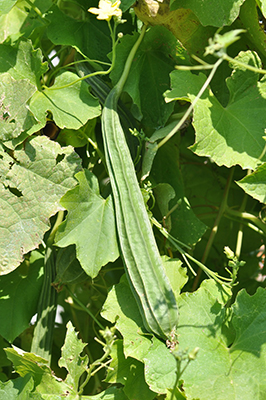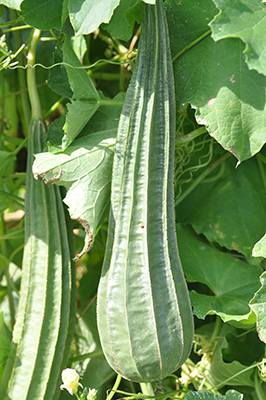Lufa







| ENG | Luffa |
| SK | Lufa |
| CZ | Lufa |
| PL | Trukwa, gabczak |
| HU | Lufa |
Using
Fruits of two species L. aegyptiaca (long club-shaped) and L. acutangula (long ridged, ribbed, or angled) are cultivated and eaten as a vegetable. The fruit must be harvested at a young stage of development to be edible. When the fruit is fully ripened, it is very fibrous. In that stage the fruit is the source of the loofah scubbing sponge used in bathrooms and kitchens.
| I. | II. | III. | IV. | V. | VI. | VII. | VIII. | IX. | X. | XI. | XII. | |||||||||||||
| Sowing | ||||||||||||||||||||||||
| Planting | ||||||||||||||||||||||||
| Harvest / edible gourds | ||||||||||||||||||||||||
| Harvest / fully mature | ||||||||||||||||||||||||
Botanical description and occurrence:
Luffa gourds are native to the warmer regions of the world, like southern Asia where they originated, and grown as annuals in the cooler zones. Luffa is a genus of the Cucurbitaceae family and includes many cultivated and wild varieties. The normal height of the plant is 1.5 to 2.0 meters. Part of plants are poison if ingested. Bloom color is bright yellow and bloom time is mid summer. Foliage is smooth textured, veined, leathery textured. The vines can grow 10 m. Propagation methods are from seeds, sow indoors before last frost or direct sow after last frost. Luffa requires 150 – 200 warm days to mature. It does not cross-pollinate outside.
Why to have the plant in your garden:
The immature is a healthy vegetable prepared like squash. When fully grown and mature, can be put to work scrubbing and cleaning, insulating and sound-proofing your tool shed, filtering and straining, and to create useful handcrafted items.
Text:
prof. Ing. Magdaléna Valšíková, PhD., Slovak University of Agriculture in Nitra, SR
Photo:
Dr. Ivana Mezeyova, Dr. Ján Mezey, Slovak University of Agriculture in Nitra, SR

